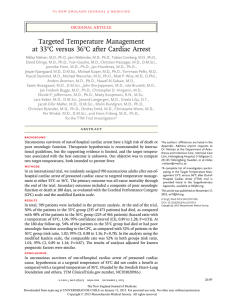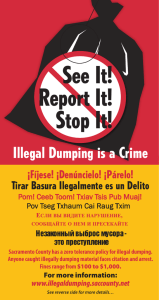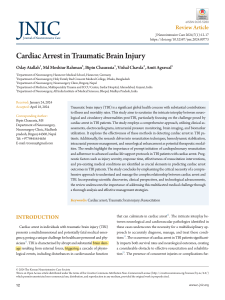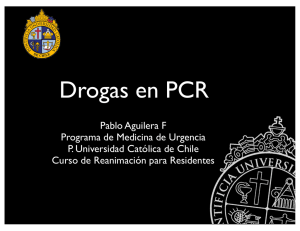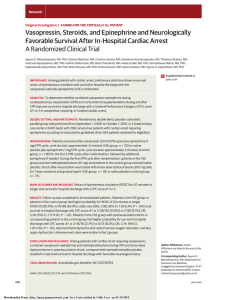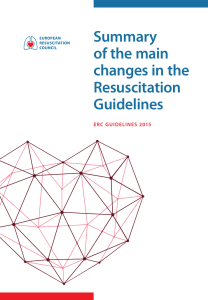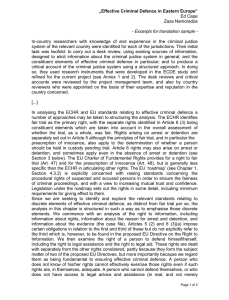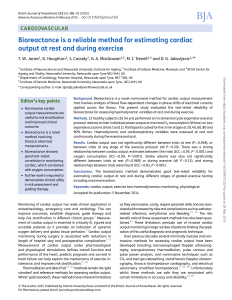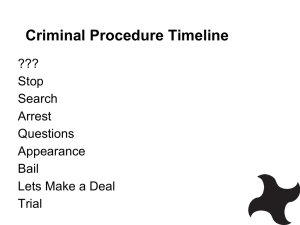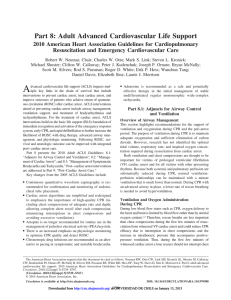Cuidados Post PCR
Anuncio
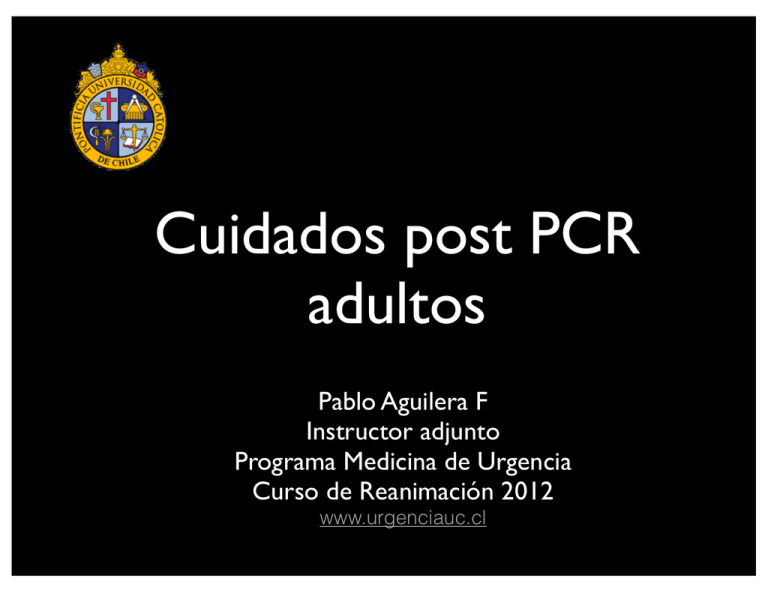
Cuidados post PCR adultos Pablo Aguilera F Instructor adjunto Programa Medicina de Urgencia Curso de Reanimación 2012 www.urgenciauc.cl Cadena de sobrevida Cuidados post PCR= Síndrome post PCR Introducción • ¿Sirve de algo reanimar personas en PCR? • Mayores costos, baja sobrevida, escases de recursos. • Evolución en el tiempo... • Nuevas terapias específicas en sindrome post PCR Introducción • “Enfermedad post reanimación”. • Acuñado por Dr.Vladimir Negovsky 1970 • 2008 nace término SPPCR guías ILCOR • “No sólo ROSC es importante sino secuelas funcionales” • Conceptos de reanimación cardiocerebral o CCR Reanimación Cardiocerebral (CCR) • Representa una serie de de terapias específicas destinadas para mejorar la perfusión durante RCP. • Implementado en Wisconsin año 2003. • Particularmente útil en pacientes con PCR presenciado: Reserva funcional de O2 ordingly, is a U.S., as a cause ths combined in 1974 (19), elines in 1992 (7) for emerCLS, with rare HCA remains rvival rates in 90; and in Los gher than 1%, l futility (22). e who receive ose with rapid ea et al. (29), with witnessed ed their EMS mmediate chest alysis of postrecommended % (29). CPR has herent pathophysiin which the arrest who receive prompt bystander resuscitation efforts. Most bystanders who witness a cardiac arrest are willing to alert EMS but are not willing to initiate bystander rescue efforts because they are not willing to perform mouth-tomouth ventilation. Training and certification in basic life Pilares CCR Three Pillars of Cardiocerebral Resuscitation Table 1 Three Pillars of Cardiocerebral Resuscitation 1. CCC (compression-only cardiopulmonary resuscitation) by anyone who witnesses unexpected collapse with abnormal breathing (cardiac arrest). 2. Cardiocerebral resuscitation by emergency medical services (arriving during circulatory phase of untreated ventricular fibrillation [e.g., !5 min]) a. 200 CCCs (delay intubation, second person applies defibrillation pads and initiates passive oxygen insufflation). b. Single direct current shock if indicated without post-defibrillation pulse check. c. 200 CCCs prior to pulse check or rhythm analysis. d. Epinephrine (intravenous or intraosseous) as soon as possible. e. Repeat (b) and (c) 3 times. Intubate if no return of spontaneous circulation after 3 cycles. f. Continue resuscitation efforts with minimal interruptions of chest compressions until successful or pronounced dead. 3. Post-resuscitation care to include mild hypothermia (32°C to 34°C) for patients in coma post-arrest. Urgent cardiac catheterization and percutaneous coronary intervention unless contraindicated. CCC " continuous chest compression. n Cardiocerebral resuscitation was begun in November 2003 in Tucson, Arizona, and by 2007 was being used throughout the majority of the state. In 2005, the AHA updated their guidelines and incorporated some of the changes made with CCR (52). In 2008, the AHA published a science advisory statement supporting chest compressions only for bystander response to adult cardiac arrest (71). Table 3 compares current aspects of CCR with the AHA 2005 guidelines and their 2008 advisory statement. Uninterrupted perfusion to the heart and brain by CCC prior to defibrillation during cardiac arrest is essential to JACCneurologically Vol. 53, No. 2, normal 2009 survival. The low incidence of bystander-initiated resuscitation efforts in patients with cardiac January 13, 2009:149–57 arrest is a major public health problem. We have long advocated CCC CPR by bystanders as a solution to this critical issue because eliminating mouth-to-mouth “rescue breathing” will go a long way toward increasing the incidence of bystander-initiated resuscitation efforts. It is exciting to see that a technique (chest compression–only CPR) that had not been heretofore formally taught results in the same or better neurologically normal survival rates than those achieved with techniques taught for decades. CCR also changes the approach of those delivering ACLS. These changes resulted in dramatic (250% to 300%) improvement in survival of patients most likely to survive: those with witnessed cardiac arrest and shockable rhythm. More aggressive post-resuscitation care, including hypothermia and emergent cardiac catheterization and PCI, is required to save even more victims of sudden cardiac arrest. Por qué cambiar conceptos?... ) oxygen (3). This is referred n. ned in Figure 1. and Walworth counties in 2004 (3). Using a historical rs following the 2000 AHA atic increase in neurologically he mean survival to hospital c function was 15% in the 3 year when CCR was provided all number of witnessed arrests ieve, suggesting a significant m et al. (5) 3-year experience ted. Neurologic intact survival 40% (including 1 patient who s, there may well have been a the first year. Nevertheless, in essed cardiac arrest and shockaramedics, there was dramatic Reprint requests and correspondence: Dr. Gordon A. Ewy, University of Arizona Sarver Heart Center, University of Arizona College of Medicine, Tucson, Arizona 85724. E-mail: gaewy@ aol.com. Figure 2 Neurologically Normal Survival of Patients With Witnessed Out-of-Hospital REFERENCES Cardiac Arrest and a Shockable Rhythm 1. Ewy G. Cardiocerebral resuscitation: the new cardiopulmonary resusThis figure contrasts the percent of patients with witnessed out-of-hospital car- 2005;111:2134 – 42. citation. Circulation 2. Kern KB, Valenzuela TD, Clark LL, et al. An alternative approach to diac arrest and a shockable electrocardiographic rhythm upon arrival of emeradvancing resuscitation science. Resuscitation 2005;64:261– 8. gency medical services (EMS) who survived neurologically intact before MJ, Kennedy KW, Ewy GA. Cardiocerebral resuscitation 3. Kellum survival of patients with out-of-hospital cardiac arrest. Am J (cardiopulmonary resuscitation [CPR]) and after the institution ofimproves cardiocerebral Med 2006;119:335– 40. resuscitation (CCR). Of note is the fact that only 1 patient in the CCR group received hypothermia therapy post-resuscitation. The approach used by EMS during the CPR period was that of the 2000 American Heart Association and 11. 12. 13. 14. 15. 16. 17. 18. 19. 20. 21. 22. 23. 24. 25. 26. 27. Fisiopatología • Componentes del SPPCR – Daño Cerebral post PCR – Disfunción Miocárdica post PCR – Respuesta Sistémica a isquemia/reperfusión – Persistencia de Patología precipitante de PCR Isquemia global y reperfusión 10 Neumar et al 6-12 hours Immediate Early Intermediate Prognostication 72 hours Rehabilitation Rehabilitation Recovery Disposition Prevent Recurrence 20 min Goals Limit ongoing injury Organ support ROSC Phase Figure. Phases of post– cardiac arrest syndrome. 51 children who survived out-of-hospital cardiac arrest had either pediatric CPC 1 to 2 or returned to their baseline neurological state.20 The CPC is an important and useful outcome tool, but it lacks the sensitivity to detect clinically Post–Cardiac Arrest Syndrom from 8% to 16%.22,23 Although this is clearly a po these patients can and should be considered donation. A number of studies have reported no d transplant outcomes whether the organs were ob appropriately selected post– cardiac arrest patie other brain-dead donors.23–25 Non– heart-beating tion has also been described after failed resuscitat after in- and out-of-hospital cardiac arrest,26,27 bu generally been cases in which sustained ROSC achieved. The proportion of cardiac arrest patie the critical care unit and who might be suitable beating donors has not been documented. Despite variability in reporting techniques, little evidence exists to suggest that the in-hospi rate of patients who achieve ROSC after cardia changed significantly in the past half-century. T artifactual variability, epidemiological and in post– cardiac arrest studies should incorporate w standardized methods to calculate and report mo at various stages of post– cardiac arrest care, long-term neurological outcome.16 Overriding th a growing body of evidence that post– cardiac impacts mortality rate and functional outcome. IV. Pathophysiology of Post–Car Arrest Syndrome The high mortality rate of patients who initia ROSC after cardiac arrest can be attributed t pathophysiological process that involves mult Although prolonged whole-body ischemia init global tissue and organ injury, additional dam during and after reperfusion.28,29 The unique post– cardiac arrest pathophysiology are often su on the disease or injury that caused the cardiac ar as underlying comorbidities. Therapies that focus ual organs may compromise other injured organ s Objetivos generales del manejo • Mantener adecuada oxigenación. • Mantener perfusión de órganos • Soporte de sistemas dañados • Resolución de causa de base Global ischemia-reperfusion injury post-resuscitation disease Ischemia VF = ventricular fibrillation ROSC= return of spontaneous circulation 13 Table 1. Post–Cardiac Arrest Syndrome: Pathophysiology, Clinical Manifestations, and Potential Treatments Syndrome Post– cardiac arrest brain injury Pathophysiology ● ● ● Post–cardiac arrest myocardial dysfunction ● ● Impaired cerebrovascular autoregulation Cerebral edema (limited) Postischemic neurodegeneration Global hypokinesis (myocardial stunning) ACS Clinical Manifestation ● ● ● ● ● ● ● ● ● Coma Seizures Myoclonus Cognitive dysfunction Persistent vegetative state Secondary Parkinsonism Cortical stroke Spinal stroke Brain death ● ● ● ● Reduced cardiac output Hypotension Dysrhythmias Cardiovascular collapse Potential Treatments ● ● ● ● ● ● ● ● ● ● ● ● ● Systemic ischemia/reperfusion response ● ● ● ● ● ● Persistent precipitating pathology ● ● ● ● ● ● ● Systemic inflammatory response syndrome Impaired vasoregulation Increased coagulation Adrenal suppression Impaired tissue oxygen delivery and utilization Impaired resistance to infection ● ● ● ● ● ● ● Ongoing tissue hypoxia/ischemia Hypotension Cardiovascular collapse Pyrexia (fever) Hyperglycemia Multiorgan failure Infection Cardiovascular disease (AMI/ACS, cardiomyopathy) Pulmonary disease (COPD, asthma) CNS disease (CVA) Thromboembolic disease (PE) Toxicological (overdose, poisoning) Infection (sepsis, pneumonia) Hypovolemia (hemorrhage, dehydration) ● Specific to cause but complicated by concomitant PCAS ● ● ● ● ● ● ● ● Therapeutic hypothermia177 Early hemodynamic optimization Airway protection and mechanical ventilation Seizure control Controlled reoxygenation (SaO2 94% to 96%) Supportive care Early revascularization of 171, 373 AMI Early hemodynamic optimization Intravenous fluid97 Inotropes97 IABP13,160 LVAD161 ECMO361 Early hemodynamic optimization Intravenous fluid Vasopressors High-volume hemofiltration374 Temperature control Glucose control223,224 Antibiotics for documented infection Disease-specific interventions guided by patient condition and concomitant PCAS AMI indicates acute myocardial infarction; ACS, acute coronary syndrome; IABP, intra-aortic balloon pump; LVAD, left ventricular assist device; EMCO, extracorporeal membrane oxygenation; COPD, chronic obstructive pulmonary disease; CNS, central nervous system; CVA, cerebrovascular accident; PE, pulmonary embolism; and PCAS, post– cardiac arrest syndrome. excitotoxicity, disrupted calcium homeostasis, free radical Prolonged cardiac arrest can also be followed by fixed or Daño cerebral post PCR • Causa frecuente de morbi-mortalidad de pacientes. • En algunos trabajos es la causa de un 70% de mortalidad. • Causa: Mala tolerancia a la isquemia y respuesta a la reperfusión. Daño cerebral post PCR • Mecanismos involucrados complejos: • Toxicidad por neuromediadores • Dis-regulación de la homeostasis del calcio • Formación de radicales libres • Activación de cascadas de proteasas • Activación de mecanismos apoptóticos Daño cerebral post PCR • Se altera la auto-regulación de flujo cerebral. • Infartos e isquemia en regiones cerebrales. • Trombosis microvascular. • Más significativo si PCR es prolongado • Reperfusión hiperémica como causal de daño y edema. FSC (ml/100gr/min Hipotenso Rango de perfusión normal Edema Hipertenso Isquemia PAM (mm Hg) Brain injury after cardiac arrest 4 min 4-10 min > 10 min Duration of CA Electrical Circulatory Metabolic Electrical & Circulatory reduction of the duration of global ischemia (primary brain injury) Metabolic attenuation of post-resuscitation disease due to reperfusion injury (secondary brain injury) 4 Hypothermia after cardiac arrest Hipotermia terapéutica Hypothermia cardiac arrest a treatment that after works ! a treatment that works ! number needed to treat : 6 Curr Opin Crit Care, 2003;9:205 Crit Care Med, 2005;33(2):414 number needed to treat : 6 Curr Opin Crit Care, 2003;9:205 Crit Care Med, 2005;33(2):414 30 30 Hipotermia terapéutica • Trabajos RCT 2002 • Australiano y Europeo • Hipotermia Leve ( 32-34 grados). 36 36 Crit Care Med 2004 25 Enfermedad post Reanimación hipotermia 26 Hypothermia after cardiac arrest a treatment that works ! * * * * * * 529529 patients involved in 6 studies pacientes en 6 estudios 29 Therapeutic hypothermia duration of cardiac arrest Irrespective to the presence of shock or the initial rhythm, the predicted benefit of hypothermia is strongly dependent on the duration of cardiac arrest Oddo M, Crit Care Med, 2006;34(7):1865 27 Protocolo Hipotermia UC Protocolo0de0Hipotermia0Inducida Medicina0de0UrgenciaV0Unidad0de0Cuidados0Intensivos0PUC Nombre: Hora0Inicio: Fecha: Rut: Rut: •Paro Cardiorrespiratorio (cualquier ritmo, cualquier lugar) Lugar0inicio0de0hipotermia:00UCI0000000000000URGENCIA Criterios0de0Inclusión0(debe0cumplir0todos) Post0PCR0(cualquier0ritmo0como0causa0es0eligible) 0Duración0maniobras0menos0300min0hasta0 recuperación0pulso. Menos0de060horas0desde0recuperación0pulso0hasta0el0 minuto. Comatoso0(0no0obedece0órdenes) PAM0>0650con0no0más0de0un0vasopresor. en paciente mayores 15 años. Criterios0de0Exclusión •Duración maniobras resucitación < 45 minutos. Orden0de0no0reanimar,0status0basal0pobre,0enfermedad0 terminal Hemorragia0intracerebral0acRva PCR0de0eRología0traumáRca Crioglobulinemia Embarazo0(relaRva/0consulta0gineVobs) Cirugía0Mayor0reciente0(relaRva) Sepsis0como0causa0PCR0(0relaRva) •Retorno a circulación espontanea (RCE) Evaluar Criterios Exclusión •Paciente en coma (En Hoja Protocolo) Ingresar en carpeta Hipotermia Paciente candidato Hipotermia Examen0neurológico Apertura(ocular((((((((((((((((Verbal(((((((((((((((((((((((((((((((((((Motor(((((((((((((((((((((((((((((Troncoencéfalo Espontánea0…..000*00000000000Orientado………000*00000000000000Obedece…….000000000000000000Pupilas0reacRvas0000000000000000SI00000000NO000000000000000 Voz……………….0 0*00000000000Confuso…………00.0*00000000000000Localiza……….00000000000000000Corneales0000000000000000000000000000SI00000000NO0 Dolor0……………0 00000000000000Inapropiada……00000000000000000000ReRra………….00000000000000000Respiración0espontánea000SI00000000NO0 Ninguna………..00000000000000000Sonidos…………..0000000000000000000DecorRca…….00000000000000000Ojos0de0Muñeca0000000000000000SI00000000NO0 0 00000000000000Ninguno…………..000000000000000000Descerebra… 0 00000000000000Intubado0………..0000000000000000000Ninguno……… Registrar Historia Clínica Discutir Protocolo Con Familiares Monitorización (según -Avisar a equipo Hipotermia protocolo) Exámenes iníciales - Solicitar cama UCI ROT00000000000000000000000000000000000Bicipital00I000D0000000000000000000000000Rotuliano00000I0000000D000000000Aquiliano00000000000I000000D Indicar0fármacos0sedantes0o0Relajantes0musculares0al0momento0del0examen Item(que(presente((*)(excluye(paciente(de(protocolo Protocolo Iden>ficar(caso(elegible.(Ac>var(equipo(hipotermia(UrgenciaEUCI. 1. DiscuRr0caso0con0residente0de0UCI0o0staff0(0deben0estar0de0acuerdo0con0la0hipotermia0y0debe0haber0cama0de0UCI0disponible0en0las0 2. 3. 4. 5. 6. 7. 8. 9. 10. 11. 12. 13. 14. 15. 16. 17. 18. 19. 20. 21. 0 siguientes0horas)0.0Evaluar0causas0eRológicas0PCR0,0evaluar0necesidad0de0acRvación0hemodinamia. ECG0y00eventual0Ecocardiograca00por0cardiología. Hora0discusión:0______________0.0Si0paciente0no0es0elegible0por0UCI,00indique0razón0_____________________________000 Enviar0exámenes0de0sangre0con:0ELPV0CELLDYNV0COAGULACIÓNV0LACTATO0VENOSOV0GASES0VENOSOSV0ENZIMAS0CARDÍACASV0LIPASAV0 AMILASAVCLASIFICACIÓN 20Vías0venosas0periféricas0gruesas Foley0y0medir0diuresis0 Exponer0paciente0completamente Preparar0para0monitoreo0hemodinámico0invasivo0en0servicio0de0urgencia Registrar0temperatura0corporal0rectal0o0esofágica:0_______________ Preparar0sedación0con0midazolam0–fentanyl.0Para0SAS0score001V2 Inicio0infusión0de0SF00,9%0a04°C0.0Máximo0bolo030cc/kg0.0Velocidad0infusión00~1000ml/min0con0apuradores0de0suero0.0Hora0_______ Si0temperatura0inicial0es00<34°C,0mantener0a033°C0 Si0paciente0inicia0calofríos,0Vecuronio00,10mg/kg0x010vez Traslado0a0UPCV00en0caso0de0no0contar0con0cama0disponible La0temperatura0a0lograr0es033°C.0Luego0de0terminada0la0infusión.0Bolos02500cc00SF0frío00 Solicitar0equipo0coolgard®0a0UCI0para0hipotermia0intravascular Fijar0temperatura0a033°C0y0programar0máquina0a0enfriamiento0máximo. Vol.0total0de0cristaloides0infundidos0_________________________0000Hora0que00paciente0logra00temperatura033°C______________ Si0paciente0presenta00sangrado0significaRvo0o0inestabilidad0hemodinámica0severa,0considerar0recalentar. Hora0de0recalentamiento0_______________________000000Causa0que0moRvó0recalentamiento________________________0 Mantener0PAM0>0800Rtular00con0norV0adrenalina__________________________0000Dosis0máxima0:_______________________ Notas: Notas: Traslado UCI Inicio de Hipotermia Sedación y relajo Muscular Temperatura central 33°C Control laboratorio según protocolo Aguilera, Alvizú et al Disfunción Miocárdica post RCP • “Stunning” miocárdico • Disfunción transitoria • IC menor a 2 • 48- 72 horas de duración • Enfermedad coronaria asociada • Reperfusión precoz en todos los pacientes Reperfusión Miocárdica • • • • • • • Protocolo intervencional Hipotermia + angiografía precoz Ewy and Kern Cardiocerebral Resuscitation JACC Vol. 53, No. 2, 2009 January 13, 2009:149–57 68 pacientes 28. Bohm K, Rosenqvist M, Herlitz J, Hollenberg J, Svensson L. Survival is similar after standard treatment and chest compression only in out-of-hospital bystander cardiopulmonary resuscitation. Circulation 2007;116:2908 –12. 29. Rea TD, Helbock M, Perry S, et al. Increasing use of cardiopulmonary resuscitation during out-of-hospital ventricular fibrillation arrest: survival implications of guideline changes. Circulation 2006;114:2760 –5. 30. Steen S, Liao Q, Pierre L, Paskevicius A, Sjöberg T. The critical importance of minimal delay between chest compressions and subsequent defibrillation: a haemodynamic explanation. Resuscitation 2003; 58:249 –58. 31. Becker L, Berg R, Pepe P, et al. A reappraisal of mouth-to-mouth ventilation during bystander-initiated cardiopulmonary resuscitation. A statement for healthcare professionals from the Ventilation Working Group of the Basic Life Support and Pediatric Life Support Subcommittees, American Heart Association. Circulation 1997;96:2102–12. 32. Standards and guidelines for cardiopulmonary resuscitation (CPR) and emergency cardiac care (ECC). JAMA 1986;255:2905– 89. 33. SOS-KANTO Study Group. Cardiopulmonary resuscitation by bystanders with chest compression only (SOS-KANTO): an observational study. Lancet 2007;369:920 – 6. 34. Ewy GA. Cardiac arrest— guideline changes urgently needed. Lancet 2007;369:882– 4. 35. Abella BS, Aufderheide TP, Eigel B, et al. Reducing barriers for implementation of bystander-initiated cardiopulmonary resuscitation. A 15 vivos 50. Wik L, Hansen TB, Fylling F, et al. Delaying defibrillation to give basic cardiopulmonary resuscitation to patients with out-of-hospital ventricular fibrillation: a randomized trial. JAMA 2003;289:1389 –95. 51. Wik L, Kramer-Johansen J, Myklebust H, et al. Quality of cardiopulmonary resuscitation during out-of-hospital cardiac arrest. JAMA 2005;293:299 –304. 52. International Liaison Committee on Resuscitation. 2005 international consensus on cardiopulmonary resuscitation and emergency cardiovascular care science with treatment recommendations. Resuscitation 2005;67:181–341. 53. Aufderheide T, Sigurdsson G, Pirrallo R, et al. Hyperventilationinduced hypotension during cardiopulmonary resuscitation. Circulation 2004;109:1960 –5. 54. Aufderheide TP. The problem with and benefit of ventilations: should our approach be the same in cardiac and respiratory arrest? Curr Opin Crit Care 2006;12:207–12. 55. Schoenenberger RA, von Planta M, von Planta I. Survival after failed out-of-hospital resuscitation. Are further therapeutic efforts in the emergency department futile? Arch Intern Med 1994;154:2433–7. 56. Sunde K, Pytte M, Jacobsen D, et al. Implementation of a standardised treatment protocol for post resuscitation care after out-of-hospital cardiac arrest. Resuscitation 2007;73:29 –39. 57. Hypothermia after Cardiac Arrest Study Group. Mild hypothermia to improve the neurologic outcome after cardiac arrest. N Engl J Med 2002;346:549 –56. 96% tenían lesiones coronarias 82% con lesiones criticas OR 27 157 Respuesta sistémica a isquemia/reperfusión • Estado de Shock más severo • RCP suple la necesidad de manera parcial y muchas veces precaria. • Se activan cascadas inmunológicas y de coagulación que incrementan las infecciones y disfunciones. Respuesta sistémica a isquemia/reperfusión • Micro trombosis • SIRS post ROSC • Terapia orientada por metas Persistencia de patología precipitante de PCR • • • • • • • SCA Enfermedades pulmonares Hemorragia Sepsis Toxidromes Alteraciones HEL Otras Estrategias terapéuticas • Monitoreo estricto • Optimización hemodinámica precoz guiada por metas. • Oxigenación • Ventilación • Soporte Circulatorio. • Manejo SCA Estrategias terapéuticas • Sedación y RNM • Manejo de convulsiones • Control glicemia • Neuroprotección farmacológica. • Disfunción Adrenal. • Falla Renal Cuidados post PCR en situaciones especiales • Post hipotermia • Post trombolisis • Etc etc etc etc. Pronósticos • No existen protocolos de pronósticos establecido • Predicción Multimodal pareciera ser lo mejor. • No es útil los criterios clásicos Neumar et al 6-12 hours Immediate Early Intermediate Prognostication 72 hours Rehabilitation Rehabilitation Recovery Disposition Prevent Recurrence 20 min Goals Limit ongoing injury Organ support ROSC Phase Figure. Phases of post– cardiac arrest syndrome. 51 children who survived out-of-hospital cardiac arrest had either pediatric CPC 1 to 2 or returned to their baseline neurological state.20 The CPC is an important and useful outcome tool, but it lacks the sensitivity to detect clinically Post–Cardiac Arrest Syndrom from 8% to 16%.22,23 Although this is clearly a po these patients can and should be considered donation. A number of studies have reported no d transplant outcomes whether the organs were ob appropriately selected post– cardiac arrest patie other brain-dead donors.23–25 Non– heart-beating tion has also been described after failed resuscitat after in- and out-of-hospital cardiac arrest,26,27 bu generally been cases in which sustained ROSC achieved. The proportion of cardiac arrest patie the critical care unit and who might be suitable beating donors has not been documented. Despite variability in reporting techniques, little evidence exists to suggest that the in-hospi rate of patients who achieve ROSC after cardia changed significantly in the past half-century. T artifactual variability, epidemiological and in post– cardiac arrest studies should incorporate w standardized methods to calculate and report mo at various stages of post– cardiac arrest care, long-term neurological outcome.16 Overriding th a growing body of evidence that post– cardiac impacts mortality rate and functional outcome. IV. Pathophysiology of Post–Car Arrest Syndrome The high mortality rate of patients who initia ROSC after cardiac arrest can be attributed t pathophysiological process that involves mult Although prolonged whole-body ischemia init global tissue and organ injury, additional dam during and after reperfusion.28,29 The unique post– cardiac arrest pathophysiology are often su on the disease or injury that caused the cardiac ar as underlying comorbidities. Therapies that focus ual organs may compromise other injured organ s Post-Cardiac Arrest Syndrome Management Who needs this? Resuscitated patients with: GCS Motor score < 6 No other reason for coma Not DNR B/C or DNI status Getting Started: Algoritmo propuesto! Use 2 liters of 4 C saline (peripheral IV preferred) if initiating TH 500 ml IVF over 5 min q 20 min until CVP > 8 If no CHF, continue IVF to get MAP > 80, CVP > 8, but < 20 PA catheter if CVP >15 or > 5 liters IVF or CHF or significant vasopressor need Stat ECG, echocardiogram, & cardiology consult (Please see TH protocol for instructions regarding Stat ECG, Echo & Cards consult) Stat head CT if deemed medically necessary Initiate therapeutic hypothermia (TH) & place radial or femoral a-line Insert PreSep® CVC in subclavian or internal jugular vein Notify Super SAR for ICU bed and EEG fellow for EEG If pregnant, consult Ob/Gyn < 80 > 100 MAP CVP > 8 > 80 < 80 Start IV NTG at 10 mcg/min. Titrate to MAP < 100. Assure adequate CVP Consider Furosemide if CHF If tachycardic or ACS* w/ normal EF & Scv02 then consider Esmolol If EF is normal, use Norepinephrine (1-20 mcg/min) If EF, start Dobutamine (2.5-20 mcg/kg/min); If MAP , add Norepinephrine Ongoing hypotension, consider 2nd vasopressor If severe hypotension-> IABP 80-100 (Consider > 65 if ACS*, CHF, Shock) Yes ScvO2 65% No If evidence of shock is present: Optimize CVP if not already done (up to 20) Transfuse PRBC’s if hemoglobin 10 mg/dL Dobutamine if not already initiated Consider RHC if CVP>15 or escalating vasopressors No MAP, CVP, ScvO2 goals achieved Monitor serial lactate to rule out inadequate organ perfusion ScvO2<65% w/ shock? Yes Re-evaluate to achieve goal Consider IABP * ACS=Acute coronary syndrome Updated 07/2010
